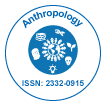
Anthropology
Open Access
ISSN: 2332-0915

ISSN: 2332-0915
Perspective - (2024)Volume 12, Issue 3
Bioanthropology, also known as biological anthropology, is a subfield of anthropology that focuses on understanding the biological and evolutionary aspects of human beings. It combines principles from biology, anthropology, genetics and archaeology to examine human evolution, adaptation and diversity. Bioanthropologists study the biological foundations of human life, seeking to uncover the processes that have shaped our species over millions of years.
Key areas of bioanthropology
Bioanthropology covers a wide range of topics, from the study of human evolution to the analysis of health and disease patterns in populations. Some of the key areas include.
Human evolution: Human evolution is one of the central topics in bioanthropology. Bioanthropologists study fossil evidence, skeletal remains and genetic data to trace the origins of humans and understand how our species evolved from earlier primates. This field focuses on the development of Homo sapiens, including key achievements such as the emergence of bipedalism (walking on two legs), the development of larger brains and the use of tools. Fossils, such as those of early hominins like Australopithecus and Homo habilis, provide important clues about the evolutionary journey of humans. Advanced dating techniques and genetic analyses also help scientists pinpoint the timeline of human evolution.
Primatology: Primatology, a sub-discipline within bioanthropology, involves the study of non-human primates (our closest living relatives), such as chimpanzees, gorillas, orangutans and monkeys. By studying primates, bioanthropologists can gain insights into the behavior, ecology and social structures of species that share a common ancestor with humans. Observing primates in the wild and in captivity allows scientists to compare their behaviour, anatomy and genetics to human traits. This comparative approach provides important evidence for understanding our evolutionary past and the origins of human characteristics.
Human adaptation and variation: Bioanthropologists study how humans have adapted biologically to diverse environments over time. This includes studying the ways in which people living in different climates, altitudes and environments develop specific physical traits. For instance, people in high-altitude regions, such as the Andes or Himalayas, may exhibit greater lung capacity and other adaptations to cope with low oxygen levels. Similarly, bioanthropologists examine genetic variations among different populations, understanding how factors like diet, disease and environment have shaped human biology. The study of human variation is important for understanding genetic diversity, the spread of diseases and the impact of cultural practices on health.
Forensic anthropology: Forensic anthropology applies principles of bioanthropology to solve legal and criminal cases. Forensic anthropologist analyses skeletal remains to determine the identity, age, sex and ancestry of individuals, as well as to reconstruct the circumstances surrounding their death. In criminal investigations, bioanthropologists work with law enforcement to identify victims and provide evidence about cause of death or trauma. Their expertise is also valuable in mass disaster scenarios, where they help identify victims based on skeletal or fragmentary remains.
Human osteology and skeletal biology: Bioanthropologists frequently study human skeletal remains to understand various aspects of human biology and history. Human osteology is the study of bones and their structure, which provides important insights into the age, sex, health and lifestyle of individuals from different time periods. Skeletal remains can also shed light on patterns of disease, trauma and nutrition throughout history. By analyzing bones, teeth and joints, scientists can reconstruct the life histories of individuals, learn about ancient populations and even study the impact of cultural practices, such as diet or physical labor, on human physiology.
The methods of bioanthropology
Bioanthropologists employ a variety of methods and techniques to gather data and test hypotheses about human biology and evolution. These methods include.
Fossil analysis: The examination of ancient bones and teeth helps scientists reconstruct the physical traits of extinct species and understand the evolutionary process.
Genetics: Advances in molecular biology and genetic sequencing allow bioanthropologists to analyze the Deoxyribonucleic Acid (DNA) of both ancient and modern humans. Genetic studies help identify evolutionary relationships, trace migration patterns and study the genetic basis of diseases.
Fieldwork: Bioanthropologists often conduct fieldwork in diverse environments, from archaeological sites to primate habitats, to collect data and observe living or fossilized evidence of human behavior.
Comparative anatomy: By comparing human anatomy with that of other primates and mammals, bioanthropologists can gain insights into the evolutionary changes that have led to human-specific traits.
The significance of bioanthropology
Bioanthropology offers a deeper understanding of the origins and biological makeup of humans, providing insights that have implications for various fields, from medicine and public health to evolutionary biology and anthropology. By studying human evolution, we can gain a clearer picture of our origins, the forces that shaped us and the ways in which we continue to adapt to our environment. In addition to study the past, bioanthropologists are also focused on the present. The study of modern human populations, including the impact of genetics and environment on health, is important for addressing contemporary issues, such as disease prevention, genetic disorders and the health disparities that exist in different populations.
Bioanthropology is a vital field that integrates biological, social and cultural perspectives to study the origins, development and adaptation of humans. By examining human evolution, primate behavior, human variation and forensic evidence, bioanthropologists help us understand who we are, where we come from and how our species has evolved over millions of years. As scientific tools and techniques continue to advance, the field of bioanthropology will undoubtedly uncover even more exciting discoveries about the biological and evolutionary history of humans.
Citation: Hendrik T (2024). Bioanthropology: Studying the Human Evolution and Biology. Anthropology. 12:238.
Received: 29-Aug-2024, Manuscript No. ANTP-24-35654; Editor assigned: 02-Sep-2024, Pre QC No. ANTP-24-35654 (PQ); Reviewed: 16-Sep-2024, QC No. ANTP-24-35654; Revised: 23-Sep-2024, Manuscript No. ANTP-24-35654 (R); Published: 30-Sep-2024 , DOI: 10.35248/2332-0915.24.12.238
Copyright: © 2024 Hendrik T. This is an open-access article distributed under the terms of the Creative Commons Attribution License, which permits unrestricted use, distribution and reproduction in any medium, provided the original author and source are credited.